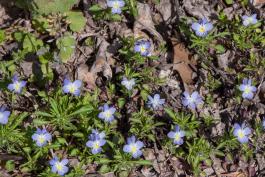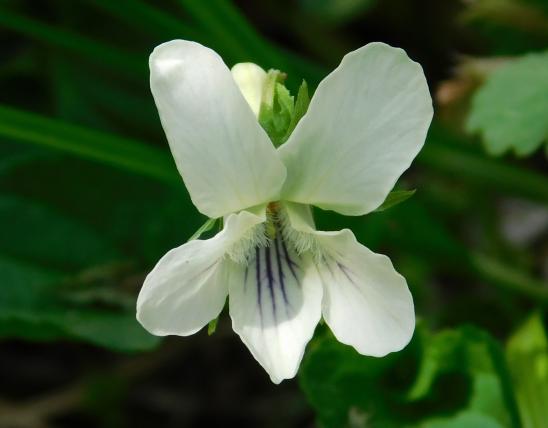
Johnny-jump-up is a winter-annual violet with a slender, vertical taproot. The small, flat-faced, pansy-like flowers are a washed-out blue or violet with a very light yellow or white center. Dark purple lines mark the petals. Plants growing on acid soils seem to have more intense coloration. Blooms March–May. Leaves are rounded, irregularly scalloped, to ¾ inch long. At the base of each leaf is a large stipule (leaflike appendage) deeply lobed like the spread tail of a bird.
This is one of 17 species of violets (genus Viola) recorded in Missouri. To learn more about Missouri's violets as a group, visit their group page.
Similar species
- Miniature pansy, viola, Johnny-jump-up, or heart’s ease (Viola tricolor). Nonnative, annual. Uncommon and sporadic when not cultivated; occasionally found reseeding from garden plants, usually in lawns and open, disturbed areas. This flat-faced Eurasian species is a common bedding plant sold at garden centers, available in a variety of colors. It often has yellowish orange and purple on the same flower, typically with a yellow throat. This is one of the parent species of the well-known garden pansy (V. xwittrockiana), which was developed in the early 1800s. Apparently V. tricolor does not persist long outside cultivation on our continent.
- Wild pansy or European field pansy (Viola arvensis). Nonnative, annual. Uncommon in the eastern half of the state, occurring on edges of forests, in old fields, and along railroads. Another flat-faced Eurasian native that escapes from cultivation. It is most similar to V. bicolor, but the flowers have the long, narrow sepals longer than the petals.
Height: to about 3 inches.

Common south of the Missouri River; scattered farther north.
Habitat and Conservation
Occurs in glades, disturbed margins of loess hill prairies, ledges and tops of bluffs, savannas, openings of bottomland and upland forests, and banks of streams, rivers, and spring branches; also in old fields, pastures, fallow fields, margins of crop fields, gardens, lawns, railroads, roadsides, and open, disturbed areas. This is not our largest violet, but it's one of the most common and widespread.
Status
Apparently a native of Missouri and North America. In the past, many researchers thought this species had been introduced to our continent from the Old World many years ago. It has many similarities to nonnative/Eurasian violet species.
For a long time, botanists have investigated this plant's relationship to the other violets in North America. As their understandings have changed, so has the scientific name. Thus in other references you may find it referred to as Viola rafinesquii and Viola kitaibeliana var. rafinesquii.
Human Connections
Like most other violets and pansies, this plant is edible, and its flowers make a pretty garnish on spring salads. Violets also have a history of being used medicinally and as garden flowers.
Ecosystem Connections
Often, when we picture herbivores, we think of large animals like cattle or deer, and even mice. But a multitude of insects also eat plants, including this and other violets. Violets, for example, are the special food plants of fritillary butterfly caterpillars.







































